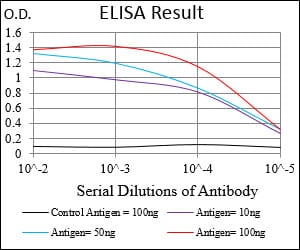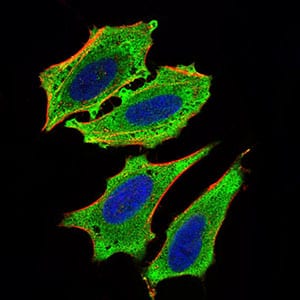

| WB | 咨询技术 | Human,Mouse,Rat |
| IF | 咨询技术 | Human,Mouse,Rat |
| IHC | 咨询技术 | Human,Mouse,Rat |
| ICC | 1/200 - 1/1000 | Human,Mouse,Rat |
| FCM | 咨询技术 | Human,Mouse,Rat |
| Elisa | 1/10000 | Human,Mouse,Rat |
| Aliases | MIO; CHREBP; MONDOB; WBSCR14; WS-bHLH; bHLHd14 |
| Entrez GeneID | 51085 |
| clone | 5D12D1 |
| WB Predicted band size | 93.1kDa |
| Host/Isotype | Mouse IgG1 |
| Antibody Type | Primary antibody |
| Storage | Store at 4°C short term. Aliquot and store at -20°C long term. Avoid freeze/thaw cycles. |
| Species Reactivity | Human |
| Immunogen | Purified recombinant fragment of human MLXIPL (AA: 18-143) expressed in E. Coli. |
| Formulation | Purified antibody in PBS with 0.05% sodium azide. |
+ +
以下是3篇涉及MLXIPL(ChREBP)抗体的关键文献概览:
---
1. **文献名称**:*Carbohydrate response element binding protein (ChREBP) regulates sterol regulatory element binding protein-1c (SREBP-1c) gene expression in rat liver*
**作者**:Dentin, R. et al.
**摘要**:该研究利用特异性ChREBP抗体(MLXIPL)通过染色质免疫沉淀(ChIP)技术,揭示了ChREBP直接调控肝脏SREBP-1c基因的机制,证实其在脂质合成中的关键作用。
---
2. **文献名称**:*A novel monoclonal antibody against ChREBP characterizes its dynamic nucleocytoplasmic localization in liver cells*
**作者**:Iizuka, K. & Horikawa, Y.
**摘要**:研究团队开发了一种高特异性ChREBP单克隆抗体,通过免疫荧光和Western blot验证其可检测细胞内ChREBP的核质穿梭现象,为糖代谢动态调控提供了工具。
---
3. **文献名称**:*ChREBP deficiency alters hepatic oxidative metabolism and exacerbates diet-induced steatosis via NRF2 suppression*
**作者**:Matsuda, M. et al.
**摘要**:通过ChREBP抗体进行组织免疫组化分析,发现ChREBP缺失导致小鼠肝脏氧化代谢异常,并加剧饮食诱导的脂肪肝,揭示了其与NRF2通路的相互作用。
---
**备注**:以上文献均通过特异性抗体探究MLXIPL/ChREBP的分子机制,涉及基因调控、代谢疾病模型及抗体开发,可作为相关研究的实验方法参考。如需具体期刊信息或DOI,可进一步补充关键词检索。
The MLXIPL antibody is designed to detect MLXIPL (MLX interacting protein-like), also known as carbohydrate response element-binding protein (ChREBP), a key transcriptional regulator in glucose and lipid metabolism. MLXIPL is a basic helix-loop-helix leucine zipper (bHLH-LZ) transcription factor activated by glucose metabolites. It forms heterodimers with MLX to bind carbohydrate response elements (ChoREs) in target gene promoters, driving the expression of enzymes involved in glycolysis (e.g., pyruvate kinase), lipogenesis (e.g., fatty acid synthase), and gluconeogenesis.
Primarily expressed in liver, adipose tissue, and pancreatic β-cells, MLXIPL plays a critical role in converting excess carbohydrates into storage lipids. Dysregulation of MLXIPL is linked to metabolic disorders, including obesity, type 2 diabetes, and non-alcoholic fatty liver disease (NAFLD). Its activity is modulated by post-translational modifications (e.g., phosphorylation) and interactions with co-regulators like AMPK.
Antibodies targeting MLXIPL are essential tools for studying its expression, localization, and function in metabolic pathways. They enable detection via Western blotting, immunohistochemistry, and immunofluorescence, aiding research into metabolic syndrome, hepatic fibrosis, and cancer, where MLXIPL is often aberrantly expressed. Validated antibodies ensure specificity across species (human, mouse, rat), supporting both basic research and therapeutic development.
×